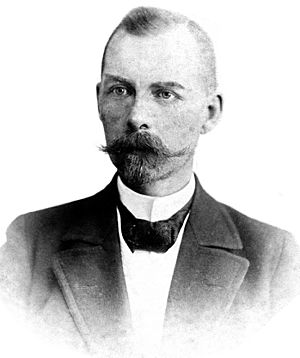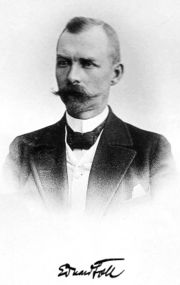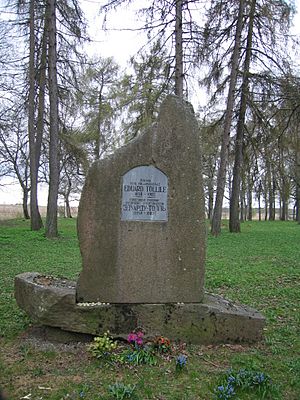Eduard von Toll facts for kids
Quick facts for kids
Eduard von Toll
|
|
|---|---|

Baron von Toll, c. 1900
|
|
| Born | 14 March [O.S. 2 March] 1858 |
| Disappeared | 26 October 1902 (aged 44) East Siberian Sea |
| Status | Missing for 123 years, 1 month and 11 days |
| Nationality | Baltic German |
| Alma mater | Imperial University of Dorpat |
| Occupation | Explorer Geologist Naturalist |
| Known for | Exploring the New Siberian Islands and leading the Russian polar expedition of 1900–1902 of the Sannikov Land |
| Signature | |
 |
|
Eduard Gustav Freiherr von Toll (born March 14, 1858 – disappeared 1902), also known as Eduard Vasilyevich Toll, was a Baltic German geologist and explorer of the Arctic. A "Freiherr" is like a Baron, a title of nobility. He is famous for leading a Russian expedition from 1900 to 1902. This trip aimed to find the legendary Sannikov Land, an island that people believed existed off Russia's Arctic coast but was never truly found. During this expedition, Toll and a small group of explorers vanished from Bennett Island. What happened to them is still a mystery today.
Contents
Early Life of Eduard von Toll
Eduard von Toll was born on March 14, 1858, in Reval, which is now Tallinn, Estonia. His family, the Toll family, was part of the Baltic German noble class. This means they were Germans who lived in the Baltic region and had a special social status.
Toll studied at the Imperial University of Dorpat and became a zoologist in 1882. Even while he was a student, he traveled a lot. He explored the Mediterranean Sea, studying the animals, plants, and rocks in places like Algeria and the Balearic Islands.
Arctic Expeditions and Discoveries
From 1885 to 1886, Toll joined an expedition to the New Siberian Islands. This trip was organized by the St. Petersburg Academy of Sciences. Eduard Toll explored several islands, including Great Lyakhovsky Island, Bunge Land, Faddeyevsky Island, Kotelny Island, and the western parts of New Siberia Island.
In 1886, Toll believed he saw an unknown land north of Kotelny. He thought it might be "Zemlya Sannikova," or Sannikov Land. This was an island that other explorers, Yakov Sannikov and Matvei Gedenschtrom, had claimed to see earlier, but its existence was never proven.
Eduard Toll was one of the first to report in detail about the many ancient animal remains found on Bolshoy Lyakhovsky Island. These were Pleistocene fossils, meaning they were from the Ice Age. He found bones of ancient mammals, like the shoulder-bone of a saber-toothed tiger. He also found a complete tree, about 15 to 20 feet long, with its leaves and cones still attached, preserved in frozen ground called permafrost. The Academy of Sciences praised his findings as a "true geographical deed."
In 1893, Toll led another expedition for the Petersburg Academy of Sciences. This time, he explored the northern parts of Yakutia. He was the first to map a large flat area between the Anabar and Popigay Rivers. He also mapped a mountain range between the Olenek and Anabar Rivers. He studied the geology of the Yana, Indigirka, and Kolyma river basins. During this expedition, his team traveled 25,000 kilometers (about 15,500 miles) in just over a year. They also measured the Earth's surface (geodesic surveys) along the way. Because of his hard work and the challenges of the expedition, the Russian Academy of Sciences gave Eduard von Toll a special medal.
In 1899, Toll took part in a voyage on the icebreaker Yermak to the shores of Spitsbergen. An icebreaker is a special ship designed to break through ice.
Toll's Last Journey: The Russian Polar Expedition
From 1900 to 1902, Eduard Toll led another major expedition for the Petersburg Academy of Sciences. This was called the Russian Polar Expedition, and they sailed on the ship Zarya. The main goal was still to find the mysterious Sannikov Land. During this trip, Toll and his team did a lot of research on water bodies (hydrographical) and land features (geographical) in the Arctic. They also studied the geology of the area.
The expedition faced very difficult ice conditions. They had to spend two winters stuck in the harsh New Siberian Archipelago. Eventually, Eduard von Toll decided to travel to Bennett Island with three other team members. They used sledges and kayaks.
The ship Zarya tried to reach Bennett Island to pick up Toll's group, but the ice was too thick. It seems Toll then decided to try and travel south towards the mainland. Sadly, no one ever saw the four men again, and their fate remains unknown.
Two search parties were sent out in the spring of 1903. One group searched the shores of the New Siberian Islands. The other, led by Aleksandr Kolchak, traveled by boat to Bennett Island. They did not find Toll or his companions. However, they did find the diaries and collections from the Zarya expedition. These items helped explain what might have happened to Baron Eduard von Toll and his team.
Remembering Eduard von Toll
Eduard von Toll's name lives on in many places on maps. The famous explorer Fridtjof Nansen named the Toll Bay on the north-west coast of the Taymyr Peninsula after him. There is also the Tollievaya River, a cape on Tsirkul Island, mountains in Novaya Zemlya, a cape on Stolbovoy Island, a strait and a plateau at Kotelny Island, and the central ice cap at Bennett Island.
Many animals and plants are also named after Baron Eduard von Toll in fields like paleontology (the study of fossils), zoology (the study of animals), and botany (the study of plants). For example, a tiny sea creature called a foraminiferan was named Dendrophyra tolli.
Baron Toll was an expert in the ancient life of Siberia. A famous Russian scientist, V. A. Obruchev, once said that Eduard von Toll was the person who first explained how ancient ice forms. This idea is still important today.
Even a modern ship, the Arctic icebreaking LNG tanker MV Eduard Toll, is named after him.
See also
 In Spanish: Eduard Toll para niños
In Spanish: Eduard Toll para niños





